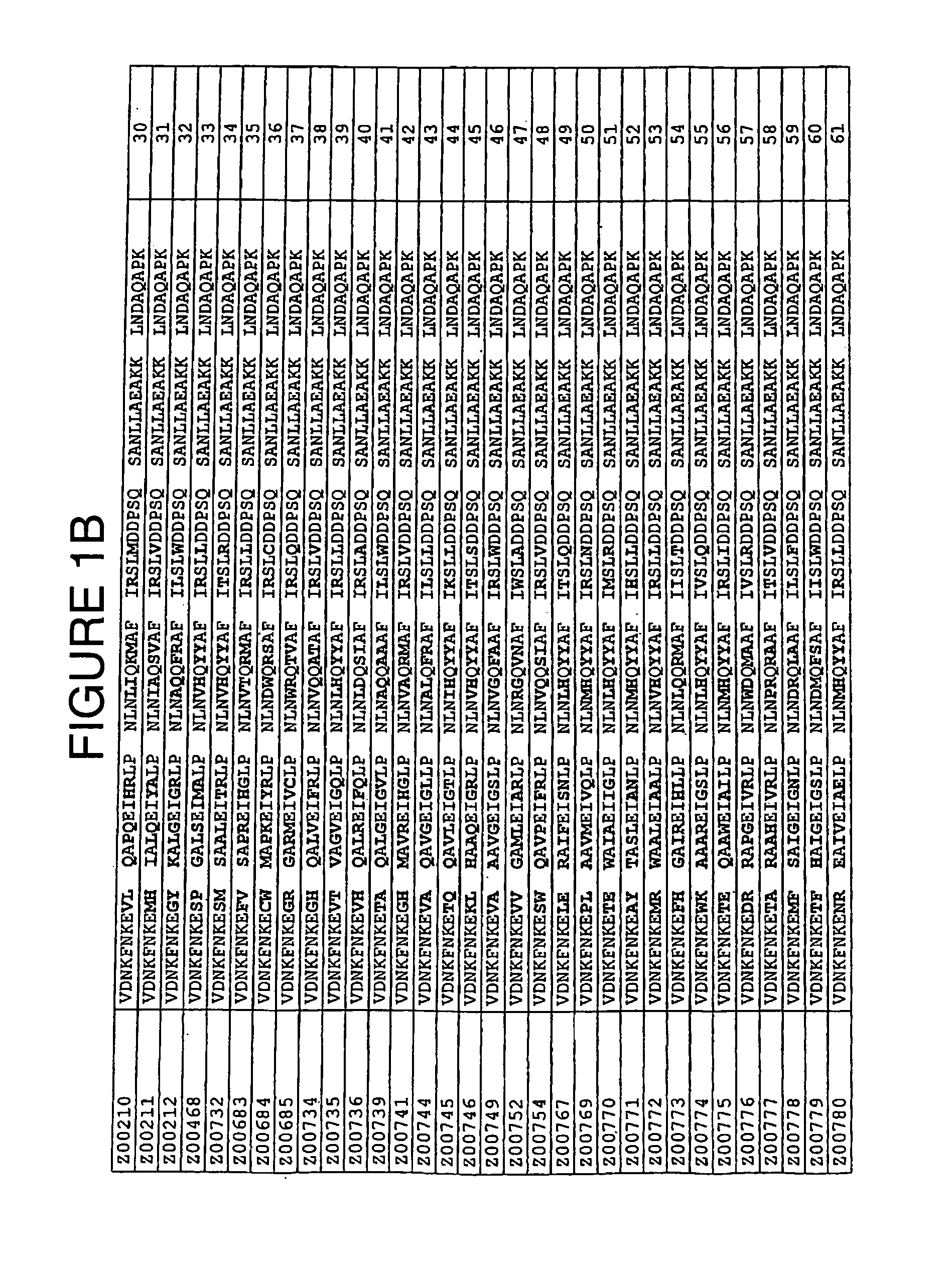Staphylococcus protein A domain mutants that bind to TNF-α
a technology of staphylococcus protein and tnf-, applied in the field of new polypeptides, can solve the problems that the antibody related derivatives against tnf- are not always the optimal choice, and achieve the effect of eliminating false positive results
- Summary
- Abstract
- Description
- Claims
- Application Information
AI Technical Summary
Benefits of technology
Problems solved by technology
Method used
Image
Examples
example 2
Expression and Characterization of TNF a Binding Polypeptides
[0084]TNF-α binding variants were selected for further characterization on the basis of i) ELISA values obtained as described in Example 1, ii) results from clustering of amino acid sequences and iii) the abundance of the sequence in the selection result. TNF-α binding variants with the amino acid cysteine in any variable positions were eliminated. The chosen clones were Z00183, Z00185, Z00192, Z00194, Z00198, Z00200, Z00203, Z00205, Z00207, Z00209, Z00210 and Z00211 (see FIG. 1). All experiments of this Example were individually conducted with all of these variants. The TNF-α binding Z variants were produced in small scale as His6-fusion proteins with an additional C-terminal cysteine residue. Purified proteins were affinity screened for TNF-α binding activity using surface plasmon resonance technology (SPR).
Expression and Purification of Fusion Polypeptides
[0085]Fusion polypeptides were expressed in E. coli BL21(DE3) cel...
example 3
Expression and Characterization of Multimeric Forms of TNF-α Binding Polypeptides
[0094]Additional selected TNF-α binding variants Z00734, Z00752 and Z00771 (see FIG. 1) were also further characterized. In the experiments of this Example, these polypeptides are sometimes collectively denoted ZTNF. All experiments were individually conducted with all of these variants. The TNF-α binding Z variants were produced as His6-tagged multimers. Affinity of purified proteins for TNF-α was measured using surface plasmon resonance technology (SPR).
Expression and Purification of Fusion Polypeptides
[0095]Fusion polypeptides were expressed in E. coli BL21(DE3) cells, by adapting the methods of Nilsson B et al, Eur J Biochem 224 (1994), 103-108 and using conventional molecular biology methods for cloning. The expression vector used encoded multimeric forms of ZTNF polypeptides, as schematically illustrated in FIG. 4.
[0096]Expression was performed as described in Example 2 above. Proteins were purifi...
example 4
De Novo Selection and Flow Cytometry Analysis of TNF-α Binding Polypeptides Using Microbead Display
[0098]A combinatorial library of Z variants, adopted for microbead display (Nord O et al, J Biotechnol 106:1-13 (2003) and U.S. Pat. No. 6,955,877), was constructed by ligating a library assembly cassette (Nord K et al (1995) Prot Eng 8:601-608) flanked by XhoI and NheI restriction sites into an XhoI and NheI restricted pET-23d-FLAG vector (Nord O et al (2003) supra). Biotinylated PCR fragments encoding the library of Z variants fused to FLAG, prepared for cell-free transcription and translation, was obtained by performing PCR on the ligation mixture with the primers AFFI-808 (SEQ ID NO:91) and AFFI-811 (SEQ ID NO:92).
[0099]PCR fragments encoding the library of Z variants were immobilized on 2×108 streptavidin-coated beads (Bangs Laboratories) at a concentration of approximately 0.60 ng / mg beads, corresponding to approximately 50 PCR fragments per bead, resulting in an Z variant librar...
PUM
| Property | Measurement | Unit |
|---|---|---|
| sizes | aaaaa | aaaaa |
| concentration | aaaaa | aaaaa |
| concentration | aaaaa | aaaaa |
Abstract
Description
Claims
Application Information
 Login to View More
Login to View More - R&D
- Intellectual Property
- Life Sciences
- Materials
- Tech Scout
- Unparalleled Data Quality
- Higher Quality Content
- 60% Fewer Hallucinations
Browse by: Latest US Patents, China's latest patents, Technical Efficacy Thesaurus, Application Domain, Technology Topic, Popular Technical Reports.
© 2025 PatSnap. All rights reserved.Legal|Privacy policy|Modern Slavery Act Transparency Statement|Sitemap|About US| Contact US: help@patsnap.com



